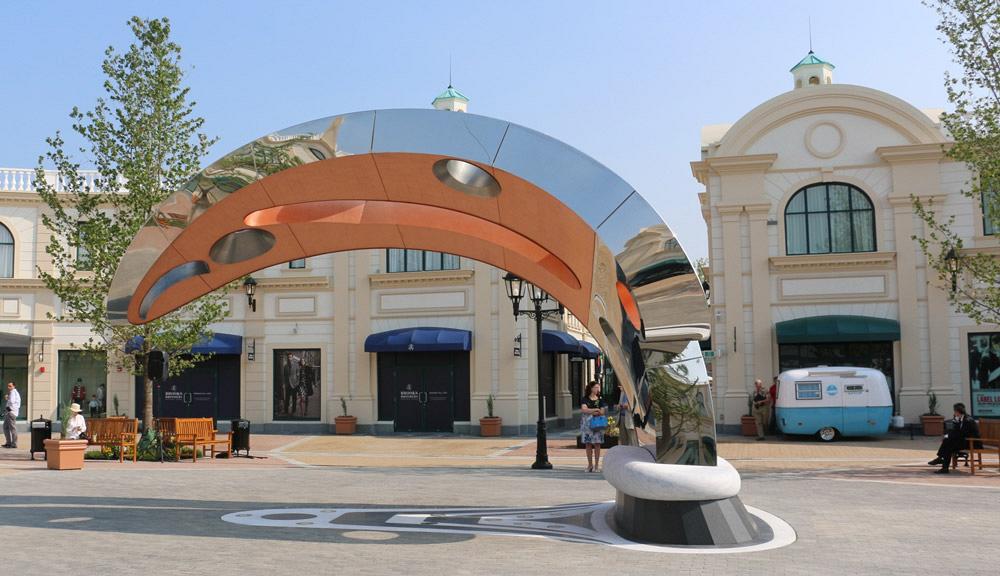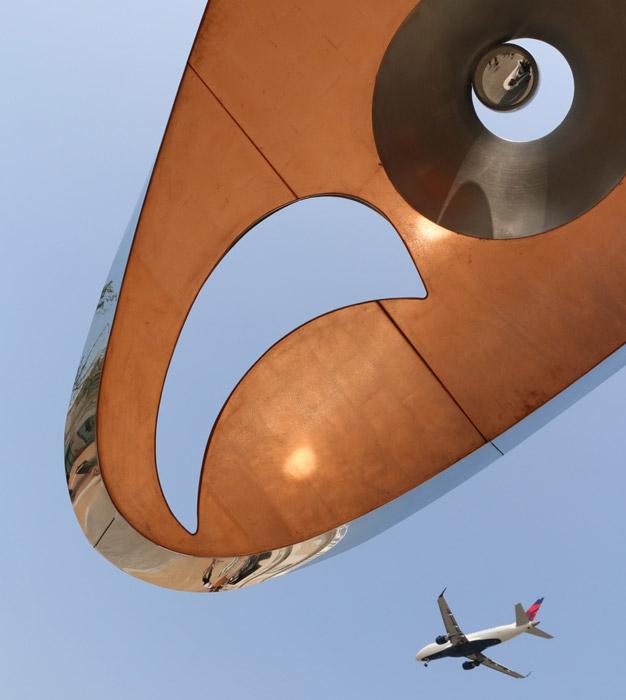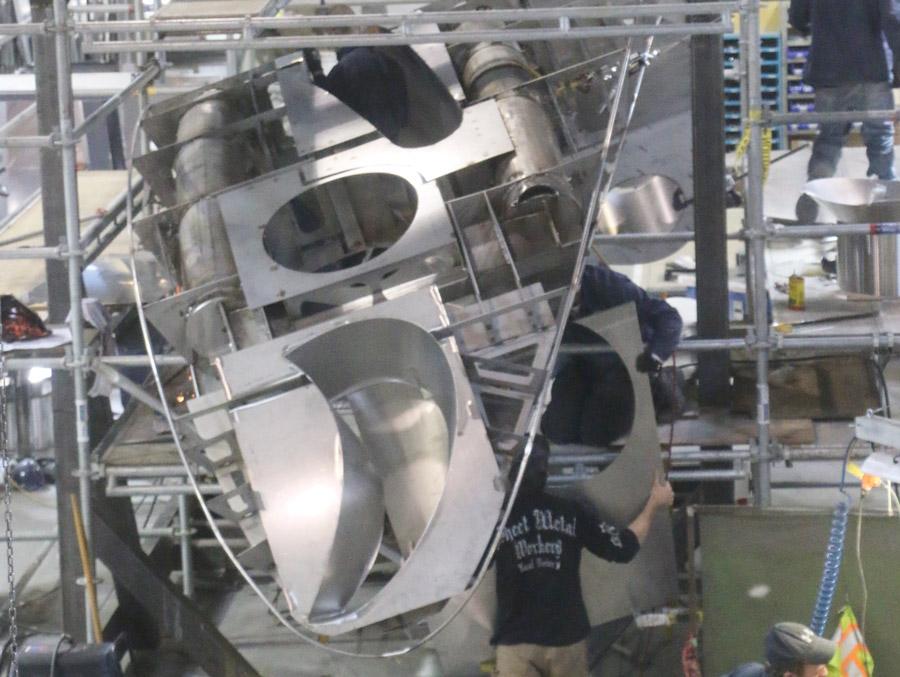- FMA
- The Fabricator
- FABTECH
- Canadian Metalworking
Categories
- Additive Manufacturing
- Aluminum Welding
- Arc Welding
- Assembly and Joining
- Automation and Robotics
- Bending and Forming
- Consumables
- Cutting and Weld Prep
- Electric Vehicles
- En Español
- Finishing
- Hydroforming
- Laser Cutting
- Laser Welding
- Machining
- Manufacturing Software
- Materials Handling
- Metals/Materials
- Oxyfuel Cutting
- Plasma Cutting
- Power Tools
- Punching and Other Holemaking
- Roll Forming
- Safety
- Sawing
- Shearing
- Shop Management
- Testing and Measuring
- Tube and Pipe Fabrication
- Tube and Pipe Production
- Waterjet Cutting
Industry Directory
Webcasts
Podcasts
FAB 40
Advertise
Subscribe
Account Login
Search
Reggin Industries Reinvents Procedures to Create a Whale of a Sculpture
Reggin Industries reinvents procedures to create public art
- By Sue Roberts
- February 1, 2016
- Article
- Bending and Forming

The beauty and grace of a baleen whale were the inspir-ation of the “Sei” sculpture designed by Michael Yahgulanaas and fabricated by Reggin Industries for the McArthurGlen Designer Outlet Mall at the Vancouver Airport.
“Sei,” a 7,902-lb. sculpture, dominates the center square at the McArthurGlen Designer Outlet Mall at the Vancouver Airport. Steel and copper brought to life artist Michael Yahgulanaas’ design that emulates the graceful, curved lines of a baleen whale as it breaks the water’s surface. Sei is the Norwegian name for the species that grows to 64 ft. long and can weigh 28 tons.
Bringing Yahgulanaas’ vision to reality required graceful coordination among the artist; the metal cutting facility; and Reggin Industries, a fabricating shop that specializes in stainless steel architectural features and located in Calgary, Alberta.
Yahgulanaas provided the conceptual details. Reggin created virtual 3-D models in SolidWorks® to explore what could be done with sheet metal while considering manufacturability, budget, and a tight production time frame.
“We started discussions with the artist in early February of 2012 and delivered the project the first week in June the same year. We had to be very disciplined in our design and manufacturing approach to avoid changes and keep moving forward. The trick was to innovate the fabrication process,” said Brett Kostka, senior designer at Reggin.
In most Reggin projects, the artist or designer develops high-level drawings and sends them out to tender. When the job is awarded, the fabricator typically develops shop drawings, moves into fabrication, and then installs in a very linear process. For “Sei” the design, drawings, and build happened concurrently.
“By applying lean manufacturing, we built what we needed as we progressed, working with the artist and structural engineers and including manufacturing in internal reviews to make sure the project would be buildable.
“We finished the structural design and ordered the parts at the same time we started designing the internal rib structure. We designed and built one step ahead of the other—sometimes within one day. This allowed us to get feedback instantly on what was being designed and make changes on-the-fly.”
The Issue of Size
The sculpture, without its base, is 158 in. high and 1233⁄8 in. wide. It had to be built in one piece, fit through the shop door, and meet shipping regulations. The build plan required innovation. “Sei” was built on an angle within its shipping frame.
Kostka explained, “since it was so tall, we had to build it at an angle—about 10 degrees off its true standing height. It started out upright in the 3-D model and I virtually changed its world by putting the floor at an angle.
“We used the shipping frame to create datum planes. We used the floor and the side walls of the frame to measure dimensions and find X, Y, or Z coordinates that related to the 3-D model.”

More than 1,500 sheets of copper leaf were applied to the whale’s underbelly by gilding artists Holly Graff and David Graff.
“Sei”’s interior, fitting for its location, resembles the support structure of an aircraft wing to combine strength with light weight. Construction started with 12-in. Schedule 40 304 SS structural pipes welded to the base plate.
“The curvature was derived from spline shapes that required close attention,” said Kostka. “They were constantly changing in radius, so we used a CNC bending process for the structural pipes. In CAD we developed CNC cutting specifications for the 304 SS structural ribs that attached perpendicularly to the pipes. Perpendicular to these ¼-in. plates were 12-ga. 304 SS ribs that created the curvature for the 12-ga. 316 SS external skins to fit to.”
Templates ensured that the curvature of each skin component was perfect. Tolerances were constantly checked to be sure they were within ±0.010 in.
Clean and Precise Cuts
Reggin relied on Empire Cutting Corp. for the precise laser cutting of the majority of components.
“My part of the project was ensuring that we cut the right lines from the 5-ft. by 10-ft. brushed and mirror-finish stainless sheets,” said Vincent Larsen, Empire’s president. “Clean cuts were critical because just about every piece was exposed, and some sheets were butted together rather than welded, which requires precision.”
Larsen received drawings as they became available and, at times, had Reggin trucks waiting as parts were completed on the Kern 400-W laser system. A preburn removed the protective vinyl from the mirrored sheets before cutting to eliminate interference with the automatic material and cutting head gap adjustment. Larsen said that they pushed the system to its upper speed limits, and accuracy was “dead on.”
Smooth Lines, Shiny Surface
The budget precluded welding and polishing the entire surface to eliminate seams, so some reveal lines were introduced. Alignment pins, tabs, offset clips, and even glue helped secure the skins to minimize welding.
“We used prefinished mirrored sheets and polished the weld lines” said Kostka.
“Some of our fabricators said “Sei” was the ‘coolest’ project they had worked on.”
Photos courtesy of Reggin Industries Inc., 10605 42nd St. SE, Calgary, AB T2C 5B9, Canada, 403-255-8141, www.regginindustries.com.

The “Sei” sculpture was built within its shipping frame at a 10-degree angle from its upright position.
Empire Cutting Corp., 4207A Ogden Road SE, Calgary, AB T2G 4R2, Canada, 403-264-2611, www.empirecutting.com
Kern Laser Systems, 1501 Industrial Drive, Wadena, MN 56482, 218-631-2755, www.kernlasers.com
About the Author

subscribe now

The Fabricator is North America's leading magazine for the metal forming and fabricating industry. The magazine delivers the news, technical articles, and case histories that enable fabricators to do their jobs more efficiently. The Fabricator has served the industry since 1970.
start your free subscription- Stay connected from anywhere

Easily access valuable industry resources now with full access to the digital edition of The Fabricator.

Easily access valuable industry resources now with full access to the digital edition of The Welder.

Easily access valuable industry resources now with full access to the digital edition of The Tube and Pipe Journal.
- Podcasting
- Podcast:
- The Fabricator Podcast
- Published:
- 04/16/2024
- Running Time:
- 63:29
In this episode of The Fabricator Podcast, Caleb Chamberlain, co-founder and CEO of OSH Cut, discusses his company’s...
- Trending Articles
AI, machine learning, and the future of metal fabrication

Employee ownership: The best way to ensure engagement

Steel industry reacts to Nucor’s new weekly published HRC price

Dynamic Metal blossoms with each passing year

Metal fabrication management: A guide for new supervisors

- Industry Events
16th Annual Safety Conference
- April 30 - May 1, 2024
- Elgin,
Pipe and Tube Conference
- May 21 - 22, 2024
- Omaha, NE
World-Class Roll Forming Workshop
- June 5 - 6, 2024
- Louisville, KY
Advanced Laser Application Workshop
- June 25 - 27, 2024
- Novi, MI


























